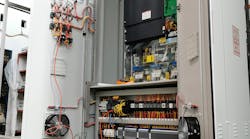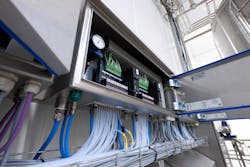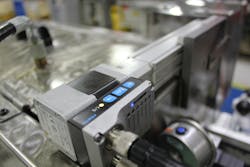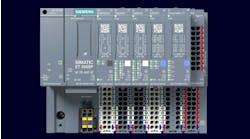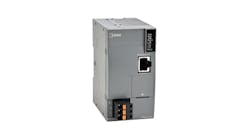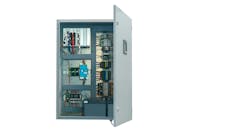Even with advancements in technology and processes, the industrial space still comes with some inherent hazards manufacturers must mitigate to help ensure the safety of their personnel, equipment and production facilities. “In many industries, including automotive, one safety hazard of high concern in working with electrically charged equipment like industrial control panels is arc flash,” notes Miesse. “An arc-flash event is a major concern for any application that incorporates electrical equipment with a current; risks can be even greater in plants where production takes place on a 24/7 basis or in challenging deployments with extreme environmental conditions.”
A large percentage of arc-flash incidents can be attributed to human error, but manufacturers can make some strategic choices in how they build their automation framework to help decrease the likelihood of arc flash, says Miesse. “The best way to avoid exposure to an arc flash is to prevent access,” he advises. “Isolating the high-voltage controls equipment from areas where employees are working is key. With unparalleled configuration options and flexibility via interchangeable panels, plus easy mounting plate assembly and installation, modular enclosures allow for fast and simple customization based on space constraints or factory floor layout. This flexibility can help to decrease the potential of an electrical current getting caught between inadequate conductors because it allows manufacturers to house high-voltage and low-voltage equipment within the same enclosure system by utilizing partition walls and individualized compartments. The controls layout can be designed so that power will be isolated to a separate section, which can follow lock-out-tag-out protocols, have proper signage and limit entrance into the hazardous section. To further reduce the possibility of electrical fault, there are modular enclosures that incorporate safety features specifically engineered to help prevent arc flash.
In food-and-beverage processing, it is critical to maintain safety and sanitation standards, particularly following the introduction of the Food Safety Modernization Act (FSMA), which contained the most sweeping food-safety regulations in the past 70 years, says Miesse. “The COVID-19 pandemic also served to heighten consumer attention and focus on hygienic manufacturing processes,” he notes. “This is where identifying industrial enclosures engineered specifically for food production environments is key in helping to maintain a safe and sanitary facility where uptime is maximized and the potential for contamination is significantly reduced.”
Cabinet-based components still offer a centralized place for marshalling signals and mounting components, explains Jeremy Andrews, product manager, industrial field connectivity, at Phoenix Contact. “It can still be a very effective solution for protecting those critical components and controlling access,” he says. “Beyond that, it allows a wider selection of products and alternatives if IP ratings or enclosures are not a concern. It really comes down to a case-by-case basis as to whether moving some of the function to de-centralized, machine-mounted makes more sense based on the configuration.”
Other than the field wiring involved, it is usually easier and less expensive to mount a system of components—especially traditional form factors, such as PLCs, relays, contactors, disconnects, fuses and fuse blocks, power distribution and terminal blocks, VFDs and communication equipment—into a control enclosure rather than mounting and wiring individually protected units externally, says Bill Dehner, technical marketing engineer, AutomationDirect. “The ability to monitor and control the environment within a control panel is a benefit for preserving the performance and prolonging the life of expensive components that reside inside,” he explains.
“Control panels also provide a centralized location for electrical components, enable assembly of the control system separate from the machinery itself and simplify field installation,” notes Dehner. “Properly assembled control panels organize wire runs between devices—no need to wire around machine components—provide protection from accidental impacts and can alleviate vibration issues with certain machines. Personnel often find work performed in a control panel, away from the machine, to be safer than working directly on the machine, and enclosures can be locked to provide an extra layer of security and access control to the components inside.”
Tom Jensen, head of system solutions and technology evangelist at Murr Elektronik, says there’s only one advantage to keeping components in the cabinet—options. “There are types of products that are new to industrial automation and so have not been ingress-hardened for use outside of the cabinet,” he explains. “For example, graphics processing units (GPUs) are now being used to power better vision systems on machines, but they are designed to let open air carry the generated heat away. They also have open connectors to allow the flexibility to be used with all sorts of CPUs and peripherals. Eventually products like these will have their scope narrowed and be defined enough to move them out of the cabinet as well, but for now a tiny cabinet will do.”
Sometimes it can be simpler and cleaner to keep the logic in one place, advises Perry Hudson, key account manager, Pepperl+Fuchs. “With advances in industrial communications and Industry 4.0, IIoT devices allow for smaller control systems and therefore smaller control cabinets,” he says. “Having all of the critical logic in one place, with only the remote I/O devices placed externally, can help with troubleshooting and machine updates. This can also help with maintenance and remote servicing, which is becoming more attractive due to labor shortages. In addition, lower-powered devices can cost less and are more readily available when supply chain shortages occur.”
There are very minimum advantages in keeping the components in the cabinets, admits Dan Barrera, product manager, ctrlX Automation, Bosch Rexroth. “From the OEM to the end users, the industry is moving toward smaller electrical enclosures and more modular systems,” he says, listing some advantages, including:
• reduced wiring and integration labor
• elimination of power losses in the cabinet
• more flexibility and scalability than traditional cabinet solutions
• cost-effectiveness.
Because not every electronic device has an IP rating, environmental protection is a key advantage of keeping components in the cabinet, explains Sandro Quintero, business development for electric automation, Festo. “Components, such as servo drives, may be too large for machine mounting. There are installation and wiring-time benefits of having components close together. OEMs mount PLCs, servo drives, variable frequency drives, power supplies and valve terminals in cabinets. Sometimes we see HMI devices in the cabinets. There are so many advantages of machine mounting that the trend of moving components out will continue (Figure 2). Control cabinets will continue to shrink. I believe it would thrill OEMs and end users to eliminate the control cabinet.”First and foremost, in-cabinet components protect from very harsh environments, agrees Kevin Davidson, operators manager at Methods Machine Tools' Detroit Technical Center. “Additionally, covered components ensure high levels of safety and security when you may want to keep unauthorized people away from components that may have hazards or tampering,” he explains. “That said, not all components offer the protection needed, and you want to have a central location for servicing the equipment.”
